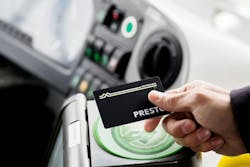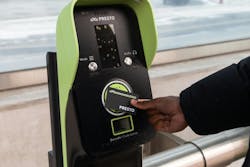Government of Ontario’s One Fare program sees early success
On Feb. 26, the government of Ontario, alongside transit agencies throughout the region, launched the One Fare program, eliminating double fares for customers transferring between participating public transit agencies in a wide swath of the Toronto area known as the Greater Golden Horseshoe.
Fare integration between regional transit providers was a well-researched and debated topic among municipal, provincial and mobility leaders. Eliminating double fares could encourage wider use of regional systems, which could save riders time and money, as well as reduce congestion in the growing area. However, elimination of double fares would also mean a loss of fare revenue as the transit industry continues to respond to the shifting ridership patterns brought about by the COVID-19 pandemic, a potential loss of fare revenue.
Enter the government of Ontario, which is spending C$117 million (US$85.1 million) per year on the program, with the goal of making regional transit easier to use. The province estimates the program will save riders who use public transit at least five times per week approximately C$1,600 (US$1,188) per year on transit costs and deliver an annual boost of up to 8 million transit rides in the region. The province has committed to fund the program without any mandated financial support from other transit agencies until March 2026, with a potential extension depending on the success of the program during the two-year period.
Participants in the One Fare program include:
- Toronto Transit Commission (TTC)
- York Region Transit (YRT)
- GO Transit
- Brampton Transit
- Durham Region Transit
- MiWay
Under the program, for example, adult fare customers transferring between the TTC and GO Transit will save C$3.30 (US$2.42) on a single trip while customers utilizing the TTC and YRT will save up to C$3.88 (US$2.44) on a single adult trip taken between the two agencies within the two-hour free transfer. According to the TTC, approximately 13 percent of its customers currently start or end their trip outside of Toronto and 87 percent of its customers travel locally within Toronto.
The program builds co-fare agreements the government of Ontario integrated in 2022 to eliminate fares between GO Transit and 12 regional transit agencies in the Greater Golden Horseshoe. The government of Ontario is working to make transit an easy and convenient choice for its growing region. By 2031, the government of Ontario will introduce two-way, all-day GO train service, every 15 minutes in key corridors in the Greater Golden Horseshoe to connect more people to transit, jobs and housing.
Vijay Thanigasalam, Ontario’s associate minister of transportation, says the launch of the One Fare program was a long time coming.
“Public transit riders like seniors, students and daily commuters who rely on public transit made it very loud and clear to the government [of Ontario] that they want to have a one fare program to make sure they eliminate the double fare, sometimes even triple fare, when they go from one transit jurisdiction to another municipal transit jurisdiction,” Thanigasalam said.
According to Tamas Hertel, YRT’s manager of service planning, the implementation of the One Fare program modernizes the region’s transportation systems.
“This is something York Region Transit staff and council have been advocating for years,” Hertel said. “There are many different jurisdictions around the world where programs like this already exist and transit customers don't see boundaries. They want to get from place to place no matter where and what jurisdiction they're going to.”
PRESTO payment system
As part of the One Fare program, many of the transit agencies involved started using the PRESTO payment system, which is a universal payment system across the region that provides the foundation upon which the One Fare program can be built by automatically calculating the discount applying it to the riders payment method. Riders can pay using a physical PRESTO card, a virtual PRESTO card through Google Wallet or their personal credit card. PRESTO is expected to be implemented on Apple Wallet later in 2024.
YRT started using the PRESTO system in 2011. According to Hertel, being able to tap various cards on a PRESTO reader makes riders comfortable paying for their fare, no matter which system they ride.
“When we first started using PRESTO on our transit system, it made management of fares easier for York Region Transit with data and digitization and for customers,” Tamas said. “It allowed them to track their travel patterns and have more options for fare media. Since then, we have worked with the province to improve the system, including with open and contactless payments. PRESTO has also allowed us to switch to fare capping.”
Metrolinx says the One Fare program has made paying for fares throughout its different transit systems seamless for customers and operators.
“We have more than 20 different transit operators, including GO Transit as a transit operator, and so when customers are moving from one area to the other, these cross- boundary changes requires a transfer and in that transfer is an extra payment,” explained Karla Avis-Birch, Metrolinx’s chief planning officer. “We want to move these kinds of barriers.”
Ridership
Avis-Birch notes feedback on the program from customers has been positive, with riders giving pros and cons of the program. Metrolinx is using the program to attract riders back to public transit post-COVID-19 pandemic.
“Post-pandemic, it's very different right now the way people are moving,” Avis-Birch said. “People are not just moving from the outer regions into the downtown of the Toronto core, they're wanting to move around the region. They're wanting to move between regions and that kind of idea of trip planning and removing those barriers really makes for a more seamless and integrated transit network.”
According to Avis-Birch, the pandemic changed the patterns of ridership for Metrolinx. Pre-pandemic, transit use on Metrolinx systems would only mostly be used in the morning and evening commutes. Post-pandemic, midday rides on Metrolinx systems have increased and more people are crossing between regions, making the need for the One Fare program more warranted.
Future of One Fare program
Tamas noted YRT and other agencies involved in the One Fare program have met with the government of Ontario in roundtable discussions on ways to improve the program. The goal is to eventually include more transit agencies in the Greater Toronto area into both the PRESTO payment system and the One Fare program.
Avis-Birch adds the One Fare program should lead to more service integration, citing the ability to make more connections between the transit agencies.
“In the future, what I see is this opening up the door and enabling us to have more service integration, making those train meets connect better, understanding what we call the first mile, last mile, about how people are going to get from their homes to the station,” Avis-Birch noted. “The road networks are jammed as they are. We only have a limited amount of parking so really creating more opportunities, more partnerships to make it easy and seamless for people to get into the transit network and get where they need to go easily.”
She noted there is an idea the One Fare program is going to resolve all the region’s transit issues, which is unrealistic, but the program will set the region up for ongoing growth. .
“This idea of sustainable regional transit network for all is an ongoing mission,” Birch said. “We are not stopping, particularly about connecting communities, and we don't know what's going to happen tomorrow, but we do want to continue to grow and reach the customers that we need to reach. I do think that, ultimately, growth is the name of the game, but not growth for growth's sake, growth in really matching the needs of the people in the region for where they need to live, work and play.”
In two months, the program has seen 5 million taps, which Thanigasalam views as a massive success but reiterates the program is young and has tons of room to grow.
“We are investing to make sure the future generation, the current generation and our seniors have the potential to go wherever they need to go without worrying about the cost of transit,” Thanigasalam said. “We not only want to make transit more affordable for everybody in the region, but more accessible so that anyone can just tap their credit or PRESTO card on a reader or by using their smartphone. This is only the beginning of what we hope is a successful partnership with transit agencies across the Greater Toronto area for years to come.”
About the Author
Brandon Lewis
Associate Editor
Brandon Lewis is a recent graduate of Kent State University with a bachelor’s degree in journalism. Lewis is a former freelance editorial assistant at Vehicle Service Pros in Endeavor Business Media’s Vehicle Repair Group. Lewis brings his knowledge of web managing, copyediting and SEO practices to Mass Transit Magazine as an associate editor. He is also a co-host of the Infrastructure Technology Podcast.



